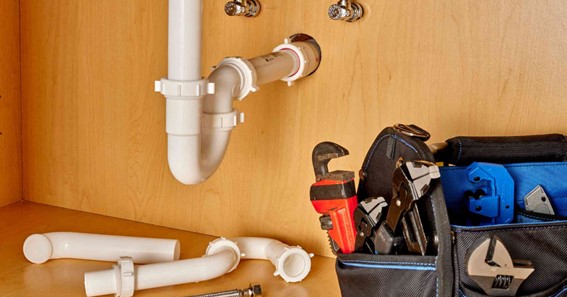Introduction
Plumbing is an essential part of every home that often goes unnoticed until a problem arises. As a homeowner, you may encounter minor issues that can be fixed with some basic plumbing knowledge. Knowing when you can tackle an issue yourself and when you should call a professional plumber is essential. This article aims to provide a comprehensive guide on mastering the art of DIY plumbing, including important tips and tricks that every homeowner should know.
Section 1: Understanding the Basics of Plumbing
The Plumbing System
Every house consists of two major subsystems. One brings freshwater in, and the other takes wastewater out. The freshwater comes under pressure from the supplier, usually a municipal system. On the other hand, drainage systems rely on gravity to transport waste and water out of the house. Understanding this basic structure is the first step towards mastering DIY plumbing.
Tools You’ll Need
Successful DIY plumbing relies on having the right tools. Some essential tools to keep in your arsenal include a plunger, wrench set, plumber’s tape, hand auger, and a pipe cutter. With these tools, you’ll be equipped to handle most basic plumbing tasks. For your plumbing equipment, check out Ipsplumbingproducts.com.
Section 2: Essential Tips and Tricks for DIY Plumbing
Dealing with Leaks
Leaks are one of the most common plumbing issues homeowners face. Before you call a professional, you can try a few DIY tricks. For instance, using a plumber’s tape (thread seal tape) can help seal pipe threads and fix minor leaks. A pipe repair clamp might do the trick for leaks in the middle of a pipe.
If you’re interested to find out more about plumbing visit Inner City Plumbing.
Unclogging Drains
A clogged drain can be a nuisance. Try a hand auger or plunger before resorting to harsh chemicals that can damage your pipes. If the clog persists, consider a drain snake.
Preventing Frozen Pipes
In colder climates, pipe freezing can become a real problem. To prevent this, ensure your pipes are adequately insulated. If they freeze, you can use a heat lamp or hair dryer to thaw them out slowly. Remember, rushing this process can result in a burst pipe.
Section 3: Knowing When to Call a Professional
Recognizing Your Limits
While DIY plumbing can save money and be rewarding, sometimes it’s best to call a professional. If a problem persists after you attempt to fix it, it’s a clear sign you need help. Additionally, tasks involving gas lines or central installations should always be left to the professionals.
Signs of Serious Plumbing Issues
Signs that require immediate professional attention include:
- Consistently low water pressure.
- Unusual noises in the pipes.
- Persistently slow drains.
- Water spots on the walls or ceiling.
These signs could indicate serious underlying issues that need addressing.
Section 4: The Importance of Regular Maintenance
Preventive Measures
Regular maintenance of your plumbing system is crucial to prevent issues. This includes:
- Routinely checking for leaks.
- Insulating your pipes.
- Regularly cleaning drains.
- Being mindful of what goes down your drains.
Seasonal Checks
Seasonal checks, especially before winter, can help prevent significant issues. This can include draining and insulating outdoor faucets, checking your water heater, and ensuring your sump pump works correctly.
Section 5: DIY Plumbing Safety
Safety First
Before embarking on any DIY plumbing project, it’s important to remember that safety comes first. Always wear appropriate protective gear, such as gloves and safety glasses. In addition, make sure you’re using the right tools for the job and that you’re using them correctly.
Turning Off the Water Supply
Before starting plumbing work, turn off the water supply to prevent flooding. It’s a simple step that many forget, but avoiding potential disasters is crucial.
Handling Gas Lines
One area where DIY plumbing should never venture is gas lines. Working with gas lines can be incredibly dangerous and should always be left to the professionals. If you smell gas in your home, evacuate immediately and contact your gas company.
Section 6: DIY Plumbing Projects You Can Try
Fixing a Leaky Faucet
A leaking faucet is a common problem usually fixed by replacing the washer. First, you’ll need to remove the handle of the faucet and the packing nut, which will reveal the stem. Remove that as well, and you’ll find the washer. If it’s damaged or worn out, replacing it will likely solve the problem.
Installing a New Showerhead
Upgrading your showerhead can be a simple DIY project. Most shower heads can be screwed off and on by hand. Use a wrench or pliers if necessary, but make sure to protect the finish on the showerhead and pipe stem with a rag.
Unclogging a Toilet
Every homeowner should know how to unclog a toilet. A good flange plunger is often all you need. For stubborn clogs, a toilet auger can be used to break up the blockage.
DIY plumbing can be an excellent way for homeowners to save money and better understand how their homes work. While only some jobs suit DIY, many common issues can be fixed with some knowledge and the right tools. Always remember to prioritize safety and know when to call in a professional. With these tips and tricks, you’re on your way to mastering the art of DIY plumbing.
Click here – Weeds No More: Unpacking the Essentials of a Weed Removal Service
Conclusion
Mastering the art of DIY plumbing can be a rewarding and cost-effective aspect of homeownership. By understanding the basics of your home’s plumbing system, having the right tools, and knowing when to call a professional, you can ensure the longevity and functionality of your plumbing system.
However, it’s crucial to remember that while DIY plumbing can solve minor issues, some problems require professional attention. Regular maintenance and knowing when to seek help will save money and prevent potential disasters. As the saying goes, “An ounce of prevention is worth a pound of cure, ” which also holds for plumbing.
